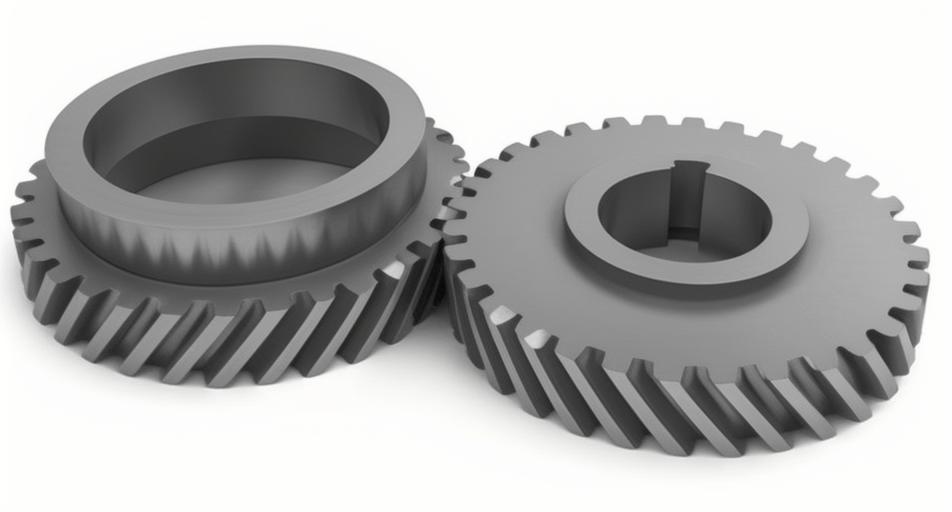Abstract
This paper investigates the machining error and compensation issues during the grinding process of internal helical gears using computer numerical control (CNC) machines. By employing the principle of homogeneous coordinate transformation, we derive the geometric error model between the workpiece and the tool. Utilizing built-in signal synchronous acquisition methods, we achieve online monitoring of machine tool errors and apply software compensation to address the primary error sources. Post-compensation, gear tooth surface accuracy is evaluated using a gear detector, revealing a noticeable reduction in errors. This research offers data and theoretical support for enhancing the precision of CNC machines.

Introduction
CNC machines are widely used in the automotive, aerospace, and military sectors, playing a pivotal role in industrial production. However, machine tool errors significantly impact processing accuracy, hindering the development of these industries. Improving machining precision while maintaining efficiency is a critical challenge.
Numerous scholars have focused on developing models to address machine tool errors, including the multi-body system theory, vector method, and homogeneous coordinate transformation. This paper specifically focuses on internal helical gear grinding, leveraging these methodologies to enhance processing accuracy.
1. Multi-Body System Kinematic Model for CNC Machines
To analyze the kinematics of internal helical gear grinding, we adopt the multi-body system theory, establishing a model for a five-axis CNC gear grinding machine with X, Y, Z, A, and C axes. The primary motion axes are X, Z, and C, while Y and A serve as auxiliary axes.
1.1 Topological Structure and Low-Order Array
The machine tool system is divided into two kinematic chains: the workpiece chain and the tool chain. Depicts the schematic of the machine’s motion axes, while illustrates the topological structure.
The low-order array of the multi-body system is presented in Table 1, outlining the relationship between adjacent bodies.
| Low-Order Operator | Body Sequence |
|---|---|
| L0(K) | 1, 2, 3, 4, 5, 6, 7 |
| L1(K) | 0, 1, 2, 3, 1, 5, 6 |
| L2(K) | 0, 0, 1, 2, 0, 1, 5 |
| L3(K) | 0, 0, 0, 1, 0, 0, 1 |
| L4(K) | 0, 0, 0, 0, 0, 0, 0 |
Table 1: Low-Order Array of the Multi-Body System
1.2 Geometric Error Model
The ideal coordinate transformation matrices between adjacent bodies are derived, considering the multi-body system. The existence of geometric errors introduces deviations from these ideal matrices. The error matrix EgW is formulated as:
EgW=TegW⋅(TgW)−1
where TegW and TgW represent the transformation matrices with and without errors, respectively.
2. Online Monitoring of Machining Errors
To enhance processing accuracy, online monitoring of machine tool errors is essential. This section outlines the methodology for signal acquisition, processing, and error analysis.
2.1 Signal Acquisition and Processing
Built-in sensors are utilized to collect dynamic position signals from each axis during the grinding process. The online monitoring system, which includes data acquisition, processing, storage, and display components.
Experimental data from the X, Z, and C axes are analyzed, revealing significant tracking errors, particularly in the Z and C axes .
2.2 Error Compensation
Software compensation is preferred over hardware compensation due to its cost-effectiveness and ease of implementation. In this study, we employ a list-based method to input pre-measured error compensation values into the CNC system, realizing real-time error correction .
3. Tooth Surface Error Analysis
To validate the effectiveness of error compensation, a Gleason 650GMS gear tester is employed to evaluate the helical gear before and after compensation.
3.1 Error Evaluation Criteria
The following error criteria are used to assess the helical gear quality:
- Fp: Cumulative pitch deviation
- fp: Individual pitch deviation
- Fα: Profile total deviation
3.2 Comparison of Pre- and Post-Compensation Results
The pre- and post-compensation error reports, respectively. Table 2 summarizes the significant improvement in accuracy after compensation.
| Error Criteria | Pre-Compensation (μm) | Post-Compensation (μm) | Improvement Level |
|---|---|---|---|
| Right Flank F_p | 28.8 | 24.1 | 6 to 5 |
| Left Flank F_p | 27.4 | 17.2 | 6 to 4 |
| Right Flank f_p | 7.9 | 6.2 | 6 to 5 |
| Left Flank f_p | 5.8 | 3.6 | 5 to 4 |
| Profile Total Deviation F_α | 11.3 | 7.3 | 7 to 5 |
Table 2: Comparison of Pre- and Post-Compensation Accuracy
4. Discussion
The study demonstrates that geometric errors in CNC machines significantly impact the machining accuracy of internal helical gears. By utilizing homogeneous coordinate transformation and online monitoring techniques, we have successfully modeled and compensated for these errors.
The software compensation method proved effective in mitigating tracking errors, particularly in the Z and C axes. The post-compensation accuracy enhancement, as evidenced by the gear tester results, underscores the practical value of this approach.
5. Conclusion
This paper presents a comprehensive framework for online monitoring and compensation of machining errors in internal helical gear grinding using CNC machines. The key findings are:
- Geometric Error Modeling: The homogeneous coordinate transformation principle enables accurate geometric error modeling between the workpiece and tool.
- Online Monitoring: Built-in sensors facilitate real-time monitoring of dynamic position signals, revealing significant errors in the Z and C axes.
- Software Compensation: Effective error compensation is achieved through software methods, significantly improving the accuracy of the machined helical gears.
Future work could explore the integration of advanced machine learning algorithms to enhance the adaptability and precision of the error compensation process.
